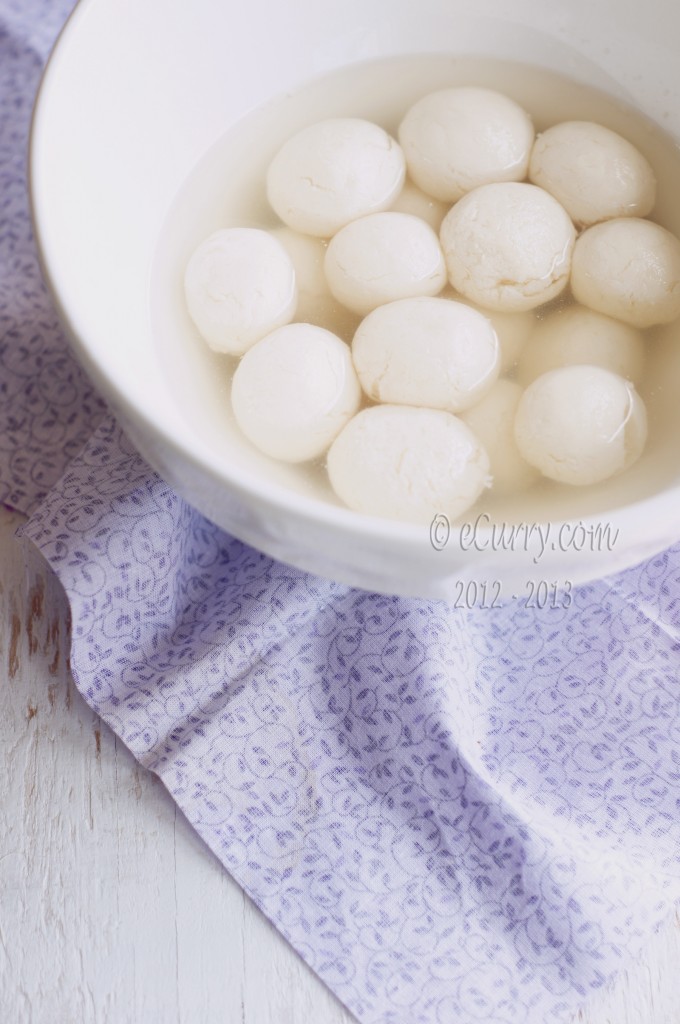
Roshogolla/Rasgulla needs to no introduction. I am sure most Indians are familiar with these lyrical, spongy balls of homemade cheese, simmered in and drunk with light sugar syrup. The story of the eastern regions of India is quite incomplete without this quintessential dessert and anyone can tune in to the “Ro-sho-gol-la” quite melodiously.
How many of you can make a traditional dessert with only three ingredients? Roshogolla/Rasgulla is one such example – minimalistic in design, pure and at the same time regal. Milk, sugar and lemon juice is all you need to have these perfectly balanced sublime confection.
Rasgulla/Roshogolla is freshly made homemade cheese balls simmered in a pot full of sugar syrup (Rosh/Ras is the syrup and Golla/Gulla is a ball/or sphere). In the eastern regions of India, Roshogolla happens to be the king of sweets. It is a region well known for sweets made with milk or rather chenna/chhana.They are as common as cookies in the western world. It is blasphemy for a sweet shop not to sell Roshogolla and as much sacrilege for a Bengali home not to have a stock of it. They are loved, craved, honored and consumed as dessert, snack or anytime treats for the sweet toothed Bengalis. And when guests arrive with no prior notice, it is not surprising to see a plateful of Roshogolla served with tea or even meals. These soft balls of cheese holds the same winning stand as the Sandesh (and I have already talked a plenty about it!). They have become a part and packet of every day life and every occasion.
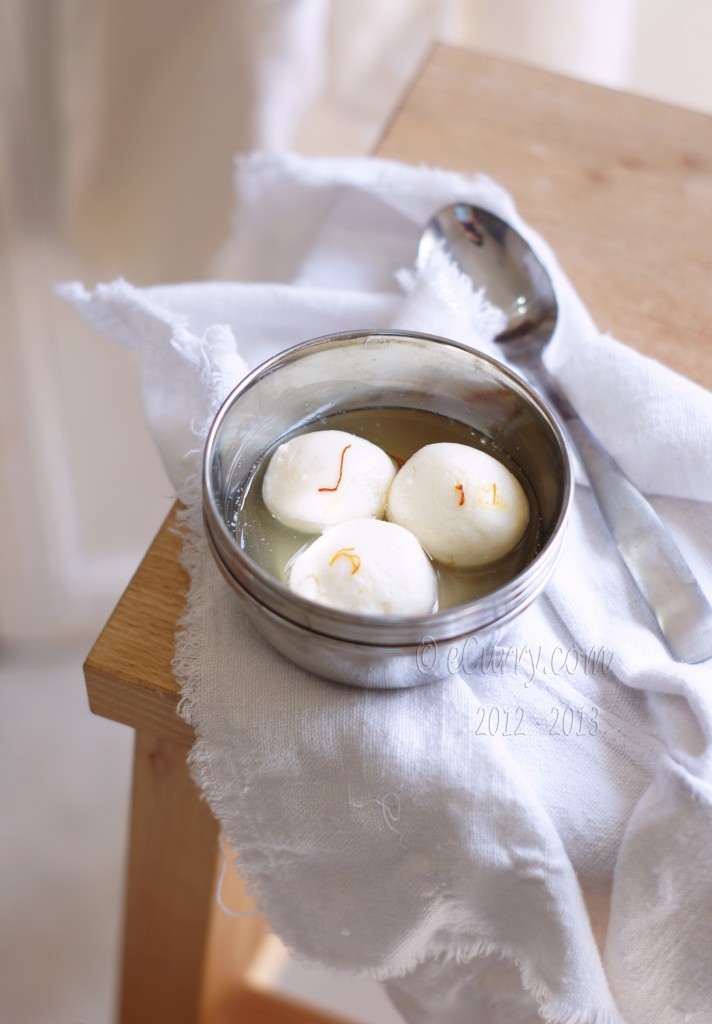
While it seems unfair to talk about Bengal without having the Rasgulla in mind, this popular and to some extent famous recipe did not originate in Bengal. It was brought in from the neighboring state of Orissa to West Bengal in the 19th century. Orissa have had the Rasgullas for many centuries. In the coastal city of Puri in Orissa, the Rasgullas has always been and are still offered to Gods in the temples.
I come from a small town. When I visited home last year after many summers I was stunned and to some extent disappointed to see so much change. The “modernization” stole a part of my childhood. I sought comfort in the old; old friends, places and streets which are heavy with our footsteps, an ancient tree truck where I sat down on a summer afternoon, behind the old brick wall which we used to be our favorite place to hide when we played hide and seek, some sweet shops and so much more. Friends have moved, many old homes had new faces behind the windows, the wall had to come down to accommodate a new polished building I did not care for. The stub of the tree still remains in my home with the roots intact and many stories to tell from hundreds of years back. There also stood some of my favorite sweet shops – unchanged just like the tree trunk, with their roots deeply embedded into traditions and quality.
The Roshogolla that these old shops sold in clay pots have fought through the changes of time and have won. They have remained chaste and unblemished. They have passed on from one generation to another and they have still managed to hold on to the heritage. The shops are no bigger than they were twenty years back. There was satisfaction and also a strange sense triumph to hold on to that pot of clay filled with Roshogolla. A victory, to say that there are certain things still capable of staying rooted amidst all the changes which I failed to deal with. There was tender comfort to see the thin white paper that covered the pot was slowly soaked through with the syrup as few of the Roshogolla piled up touching the paper. No fancy bags, ribbons or boxes. Just the plain old clay pot covered with syrup soaked paper brought back the peace within me.
There are umpteen numbers of festivities in the India. Diwali is around the corner and this is also the time for the biggest religious festival in Bengal. Durga Puja is the autumnal celebration and is usually known as the Sharodotsav ( fall festival – a way to honor the season in harmony with the religious festival). The time is a celebration of the power of female Shakti symbolized by the Goddess Durga. Durga slays Asura, symbolic of the evil, to reestablish peace on earth. It is the time for worship, time for self introspection, time for giving, time for the “new” and also to share love and food. On the occasion of Durga Puja, Roshogolla and Sandesh are the most popular sweets in any Bengali home.
I wish one and all of you peace, love and purity during this beautiful season.
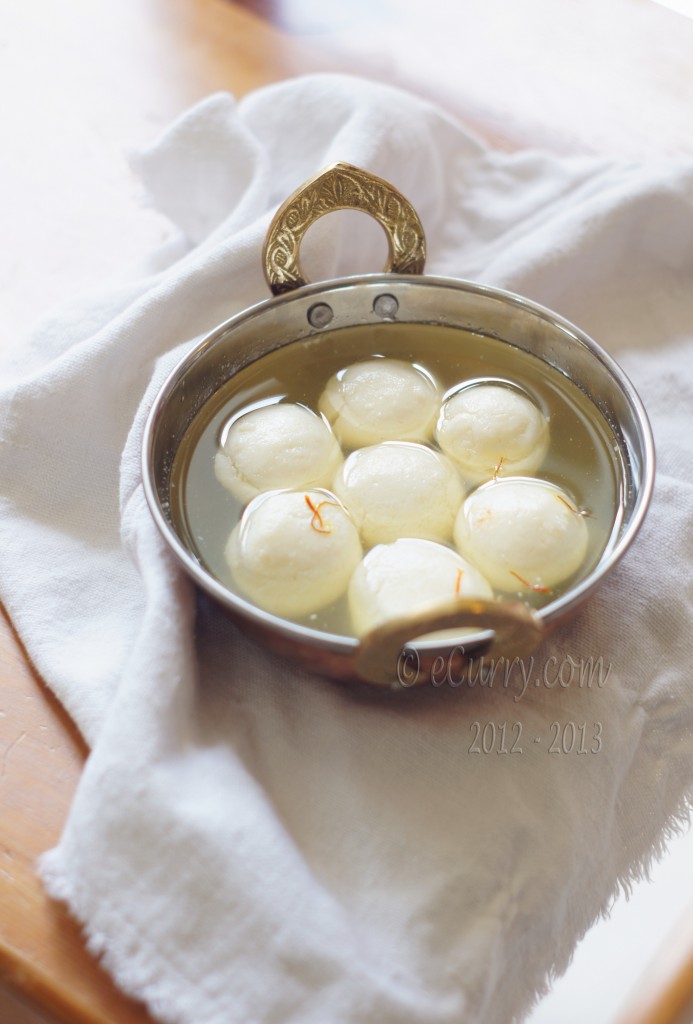
There are not many Indians who have not had this sweet and wanted more of it. Rasgullas are known to be the “face” of Bengali sweets and flows in the blood of all Bengalis. I was convinced of that when P, a teeny tiny one year old then, would point her little fingers to one of these and then croon “Gogosaaaas” and eat them up without a fuss.
A few years later T does the same; she calls them “those juicy white things that Dadubhai (grand pa) makes“. She loves eating them as much as she loves help us make them.
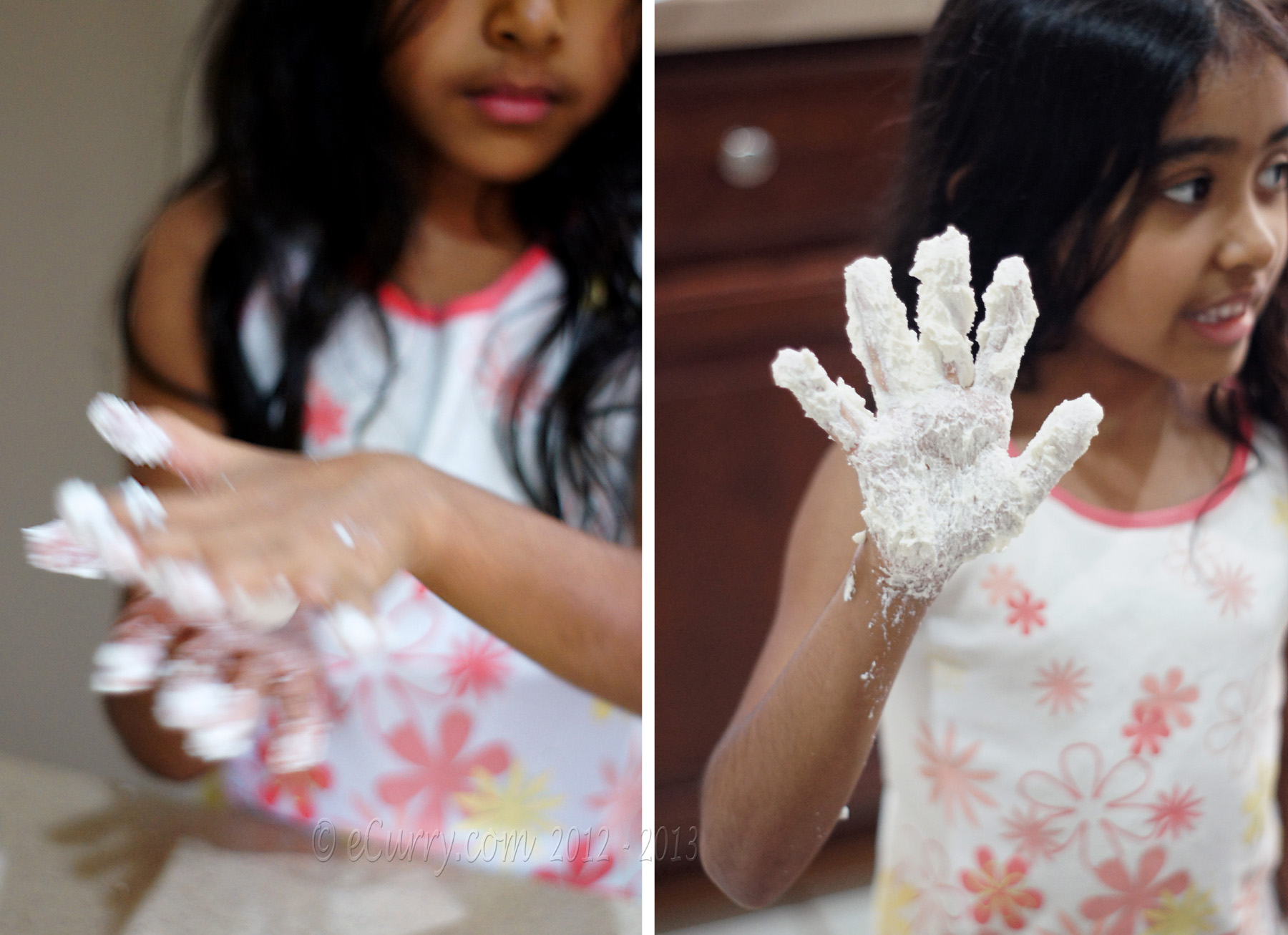
My dad makes the best Roshogolla.
Oh well, may be I am biased, but really what he makes is just perfect and I haven’t had a better one. They are as good or even better than the ones that my favorite sweet shops sell back home – fresh, warm and dripping with sweet sticky syrup. So today I have the recipe from him. He made them with very involved help of little T while I wrote down and photographed. This post will be full of photographs of Rasgulla/Roshogolla in the making . I hope the photos will make it easy for the first timers to comprehend the process a little bit better.
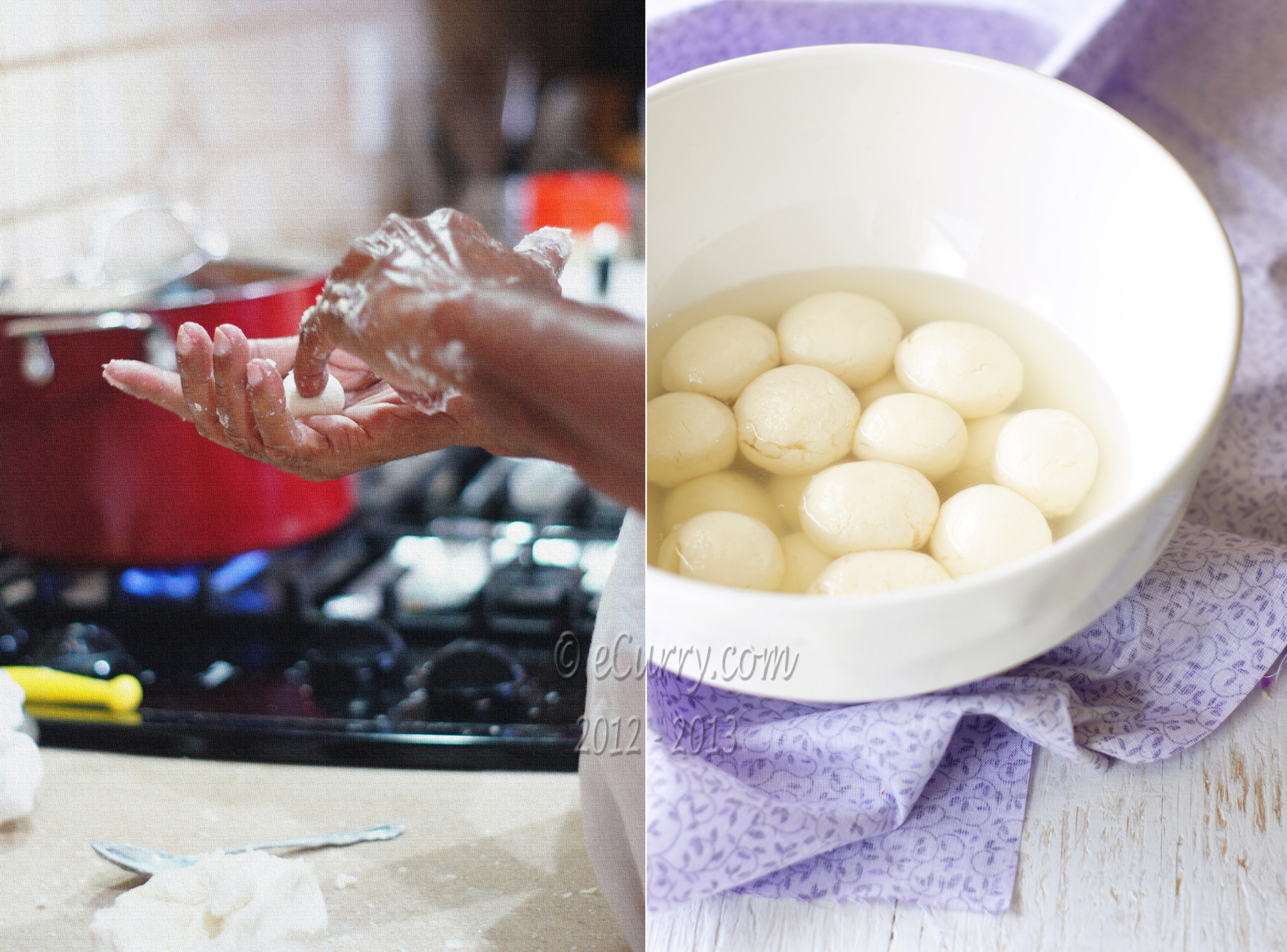
As we speak of traditions, I have it lurking at the back of my mind a scene that I have encountered too many times in my life to let it rest. With the noise and cheering the memory opens to rows of people sitting gobbling up Roshogollas in a frenzy. The sweet eating contests happened in all feasts, in all home, in all occasions. I have been away from my country for a long time; I do not know if these informal and impulsive drama happen even now. But the incidents did leave an indelible mark in my memory and the story of Roshogolla would be quite incomplete without them.
Freshly made Roshogolla is as easily available in Bengal as fish in a fish market. That I would ever have to buy canned ones made months and months back, and sealed and sent a thousand miles away from home, is something I could never comprehend twenty years back.
The canned Rasgullas are expensive and takes a little bit of time to get used to. They are not as sponge like and tender as the fresh ones and the syrup is intensely sweet and thick. And you will not have the joy of seeing a little kid running around with the cheese smeared all over their little hands trying to help you make some, if you buy them.
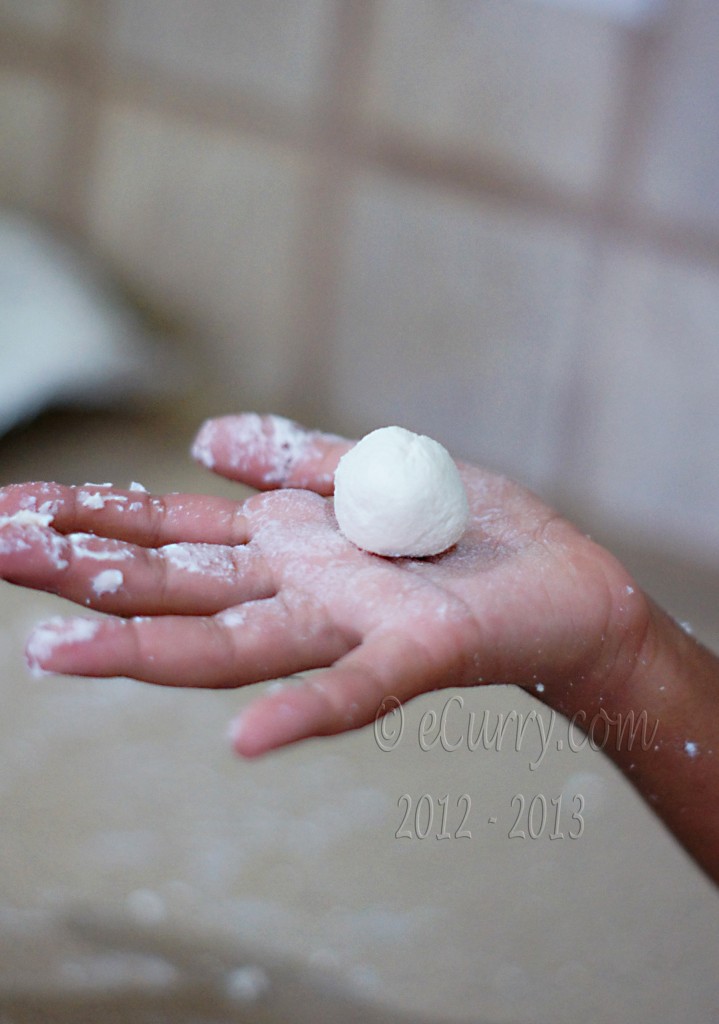
Well however much I try to speak for the canned ones, they will never be the same as the freshly made. Back in India we still buy them from our favorite shops. Unfortunately things are a bit more complicated now. We cannot walk up to the stores, and let alone make them at home whenever we want to have them!
If it is ease and convenience that you are seeking, there are ways to “freshen” up those imprisoned Rasgullas.
Here is what you do: when you open the can of Rasgullas, separate the syrup and the Rasgullas. Take half of the syrup and add some warm water to the syrup (3 parts syrup to 1 part water). Stir it in really well and simmer it for about five minutes. Now take each Rasgulla and gently squeeze the syrup from it without breaking them. Best way to do it is to take each one of them between your palms or your fingers and gently squeeze. Now drop each of the Rasgullas in the syrup which you have simmered with some water for a few minutes. Allow them to soak in the diluted warm syrup. They will be light and spongy and with just the right amount of sweet. If you want to add some flavors like rose or saffron add it to the syrup.
Little T LOVES Rasgullas more than anyone else in our family. But she refuses to eat the canned ones, even after they have been soaked in diluted syrup like the way I mentioned above. She has developed good enough taste sense to know heavenly fresh made ones and the those sat in the can for months and got refreshed at home.
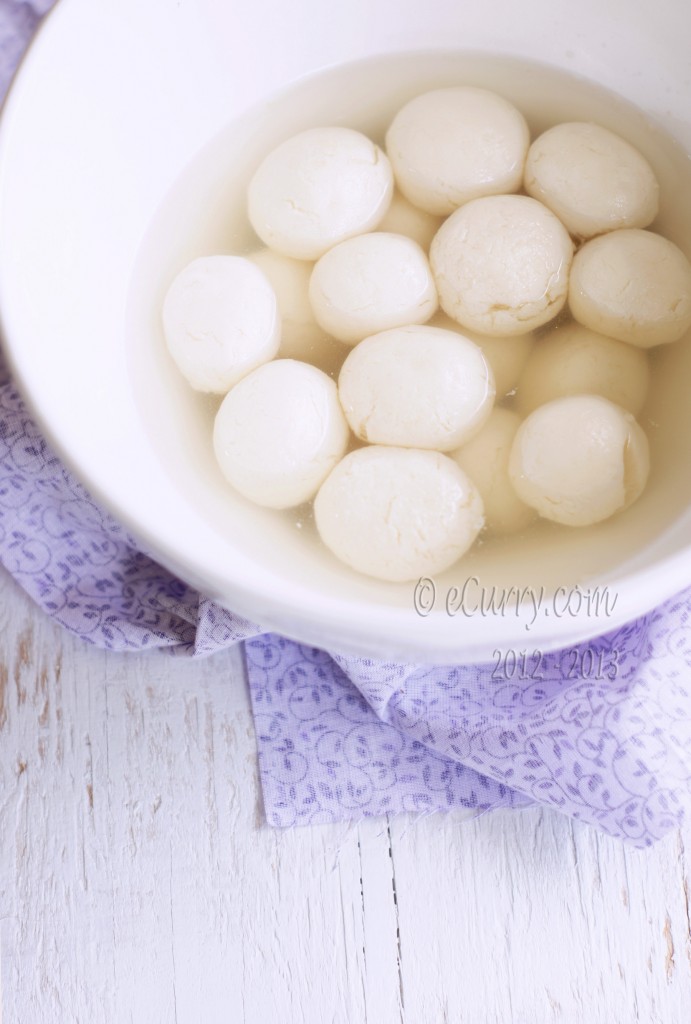
The cheese making does not take long. You have to trust me on that. The milk is split with a mild acid, separated from the whey and collected. After draining and a little bit of kneading they are rolled into little balls and cooked in a light sugar syrup. This is all there is to do.
I will tell you that learning to make these at home are worth every try, every minute and every failure. It needs practice and intuition which comes with time. There are also many derivatives of this dessert. Sometimes orange extract/zest is combined with the chenna/cottage cheese to impart the light orangish hue and also the refreshing flavor. These are called Kamalabhog. Some are sandwiched with fresh cream/thickened milk and a sprinkle of nuts and is called Malai Sandwich. And there are many more. Lakhsmi (of PureVege) has Rasgullas with orange zest, and this nuance gives a new life to this dessert.
In recent times a myriad of flavorings are used. My favorites are the orange, saffron, rose and cardamom (usually not used together).
For those of you who like to cook with kids in the kitchen, this really is great way to involve them! They love to do all the kneading and rolling and little hands can be a big help.
Here is how to make them, one step at a time…(thanks to my dad and T)
After the milk has been coagulated with a mild acid, collect the milk solids in a cheese cloth and place it in a colander to strain out the whey.
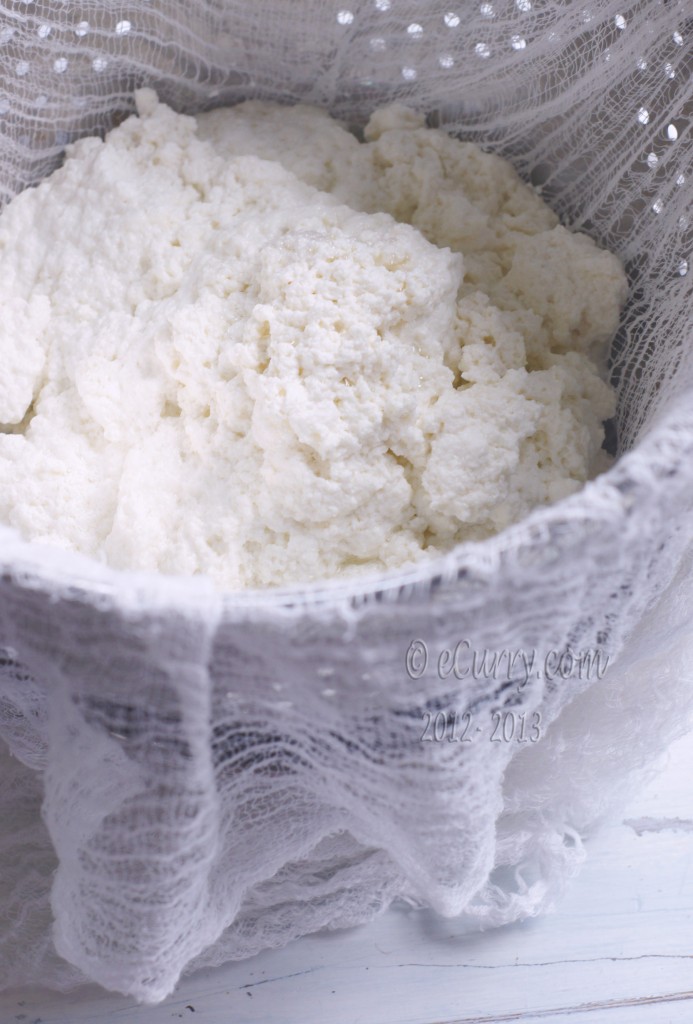
(Save the whey. It is full of nutrition and may be cooked with or make a bread dough with it or save it to split the milk if you are making another batch of Rasgullas soon enough. The whey may be used instead of the acid and will keep in the refrigerator for a couple of days).
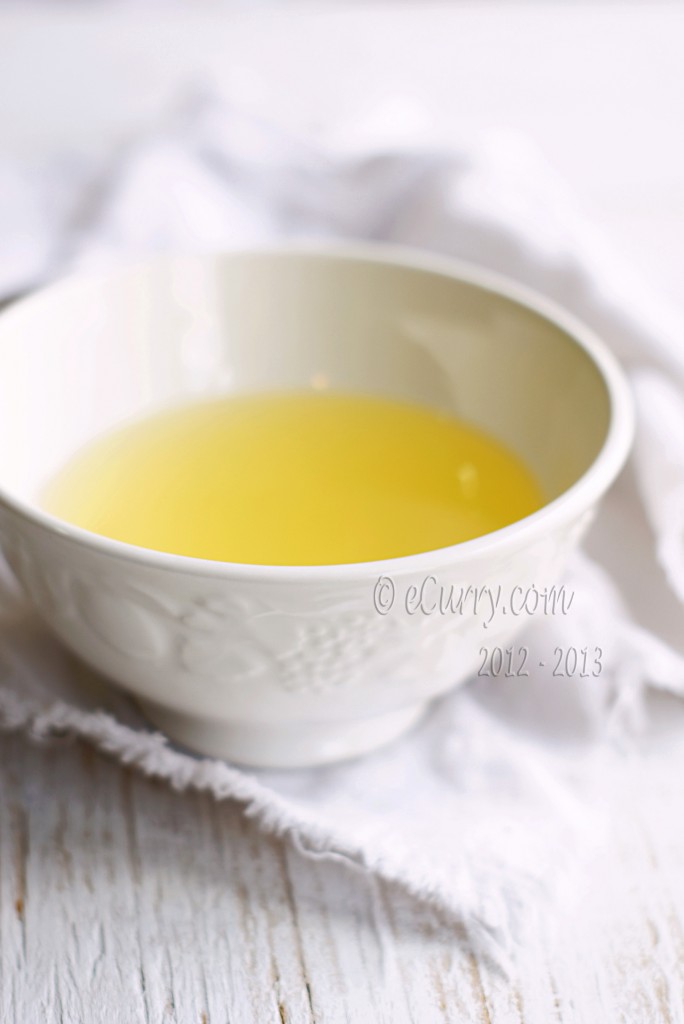
Wash the milk solids with a quick spray of cold water. This keeps the chenna/cheese soft and also washes off the trailing smell/flavor of the acid. Hang the Chenna/cheese for a few hours until the liquid has drained off.
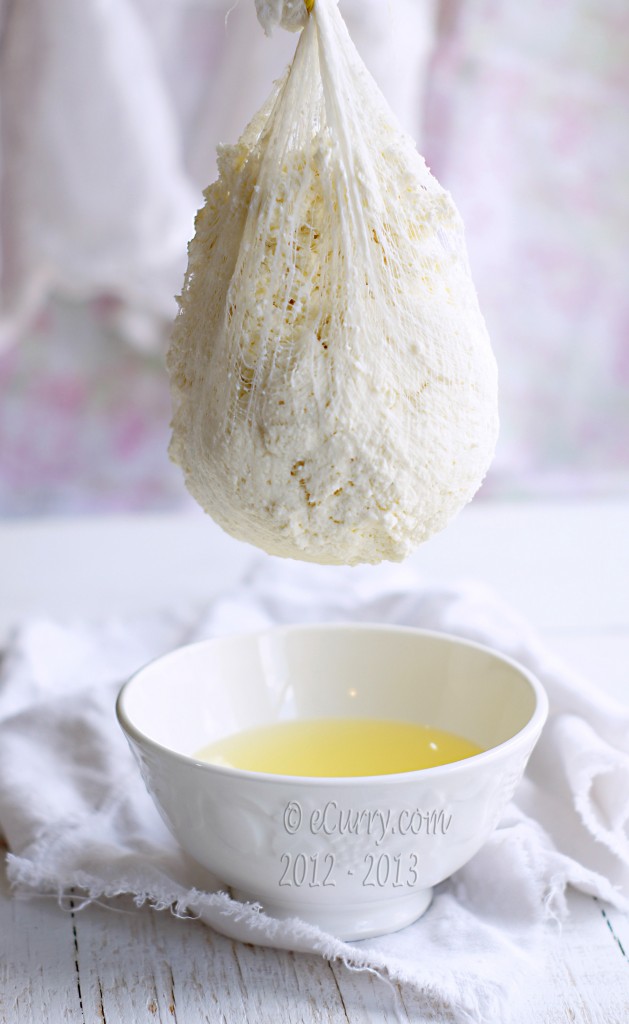
Remove cheese…
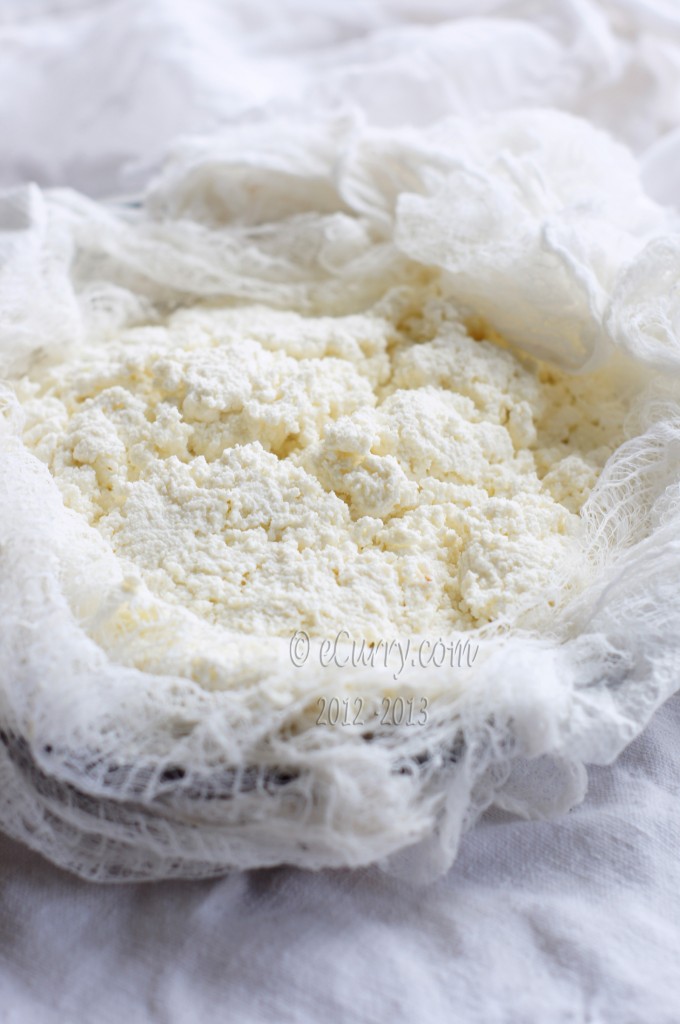
and knead/or process it (may do so in a very lightly floured surface) until smooth and the fat coats the palm of your hands. The texture should be almost like mascarpone.
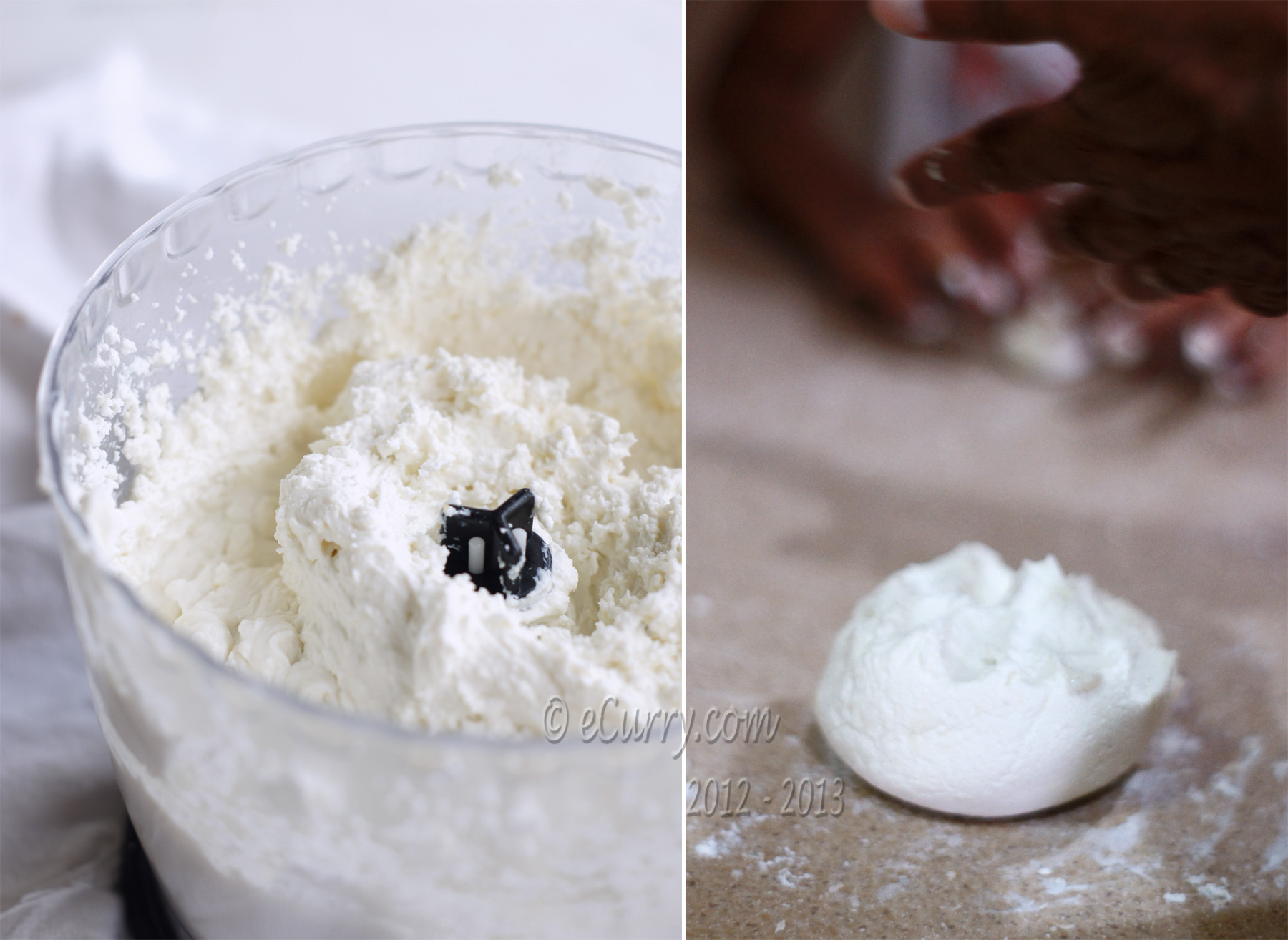
Divide the cheese and roll them in little balls.
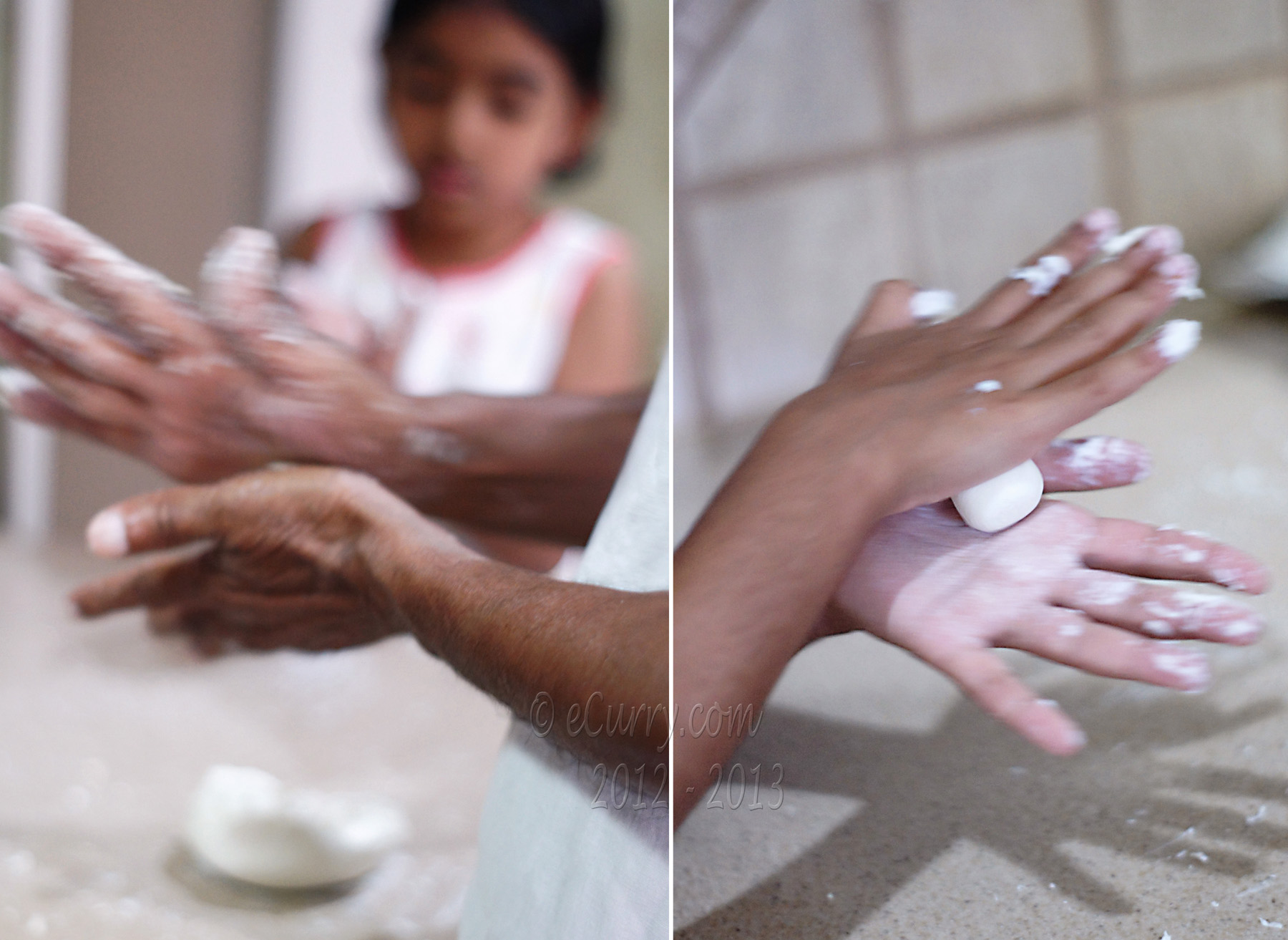
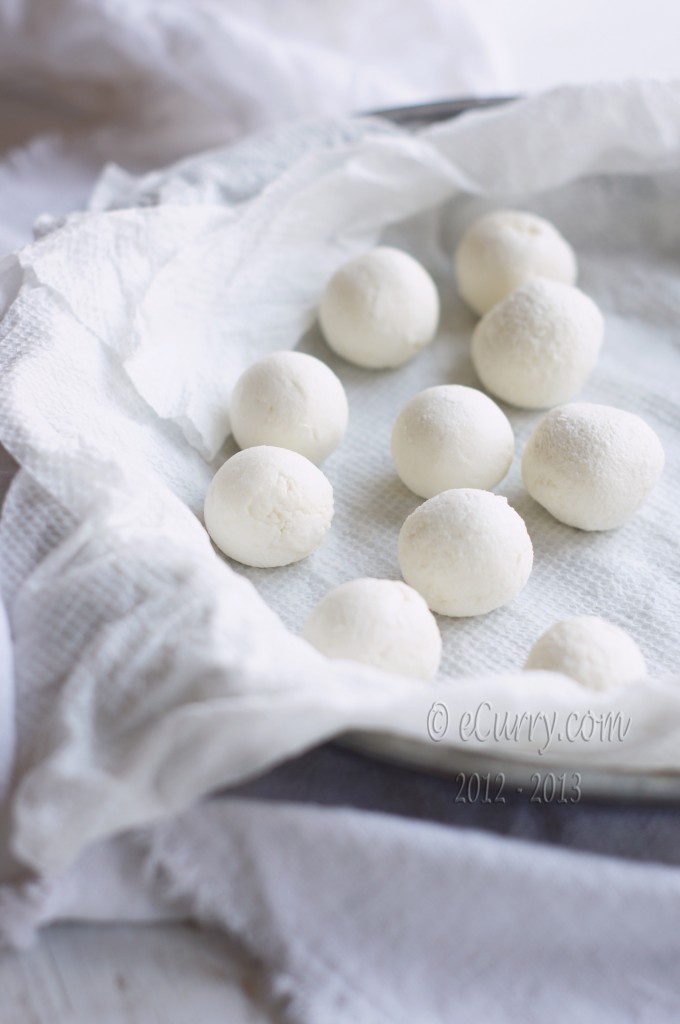
Make a little dent in each ball and drop in a sugar crystal or a pinch of large grained sugar.
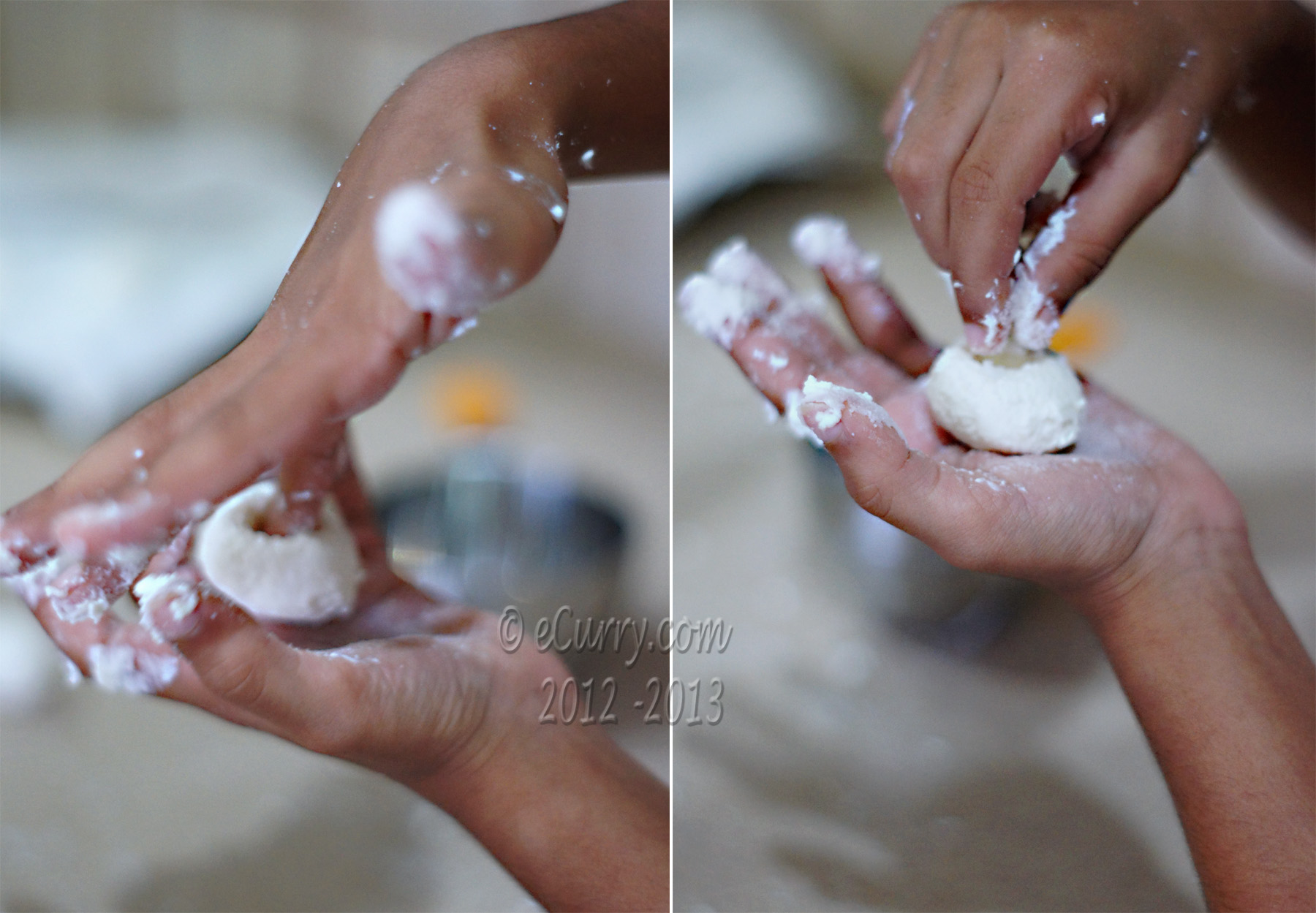
and roll them back again; make sure they are smooth and there are no cracks on the surface
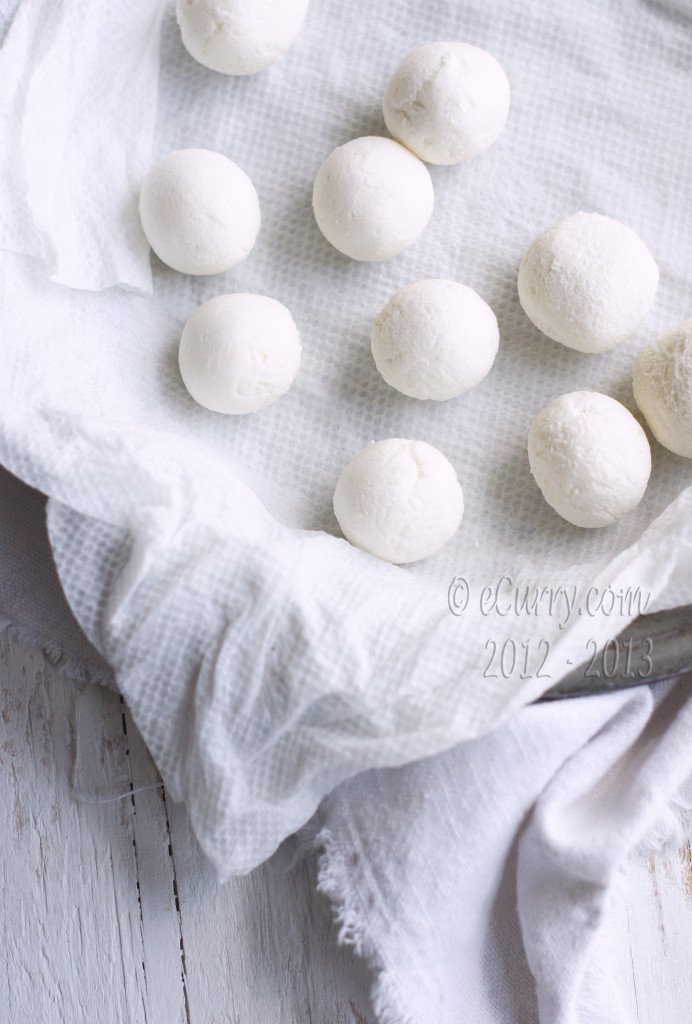
Make the sugar syrup. Time to cook the chenna balls in batches. Cover them and allow them to cook. When done they will be bigger in size.
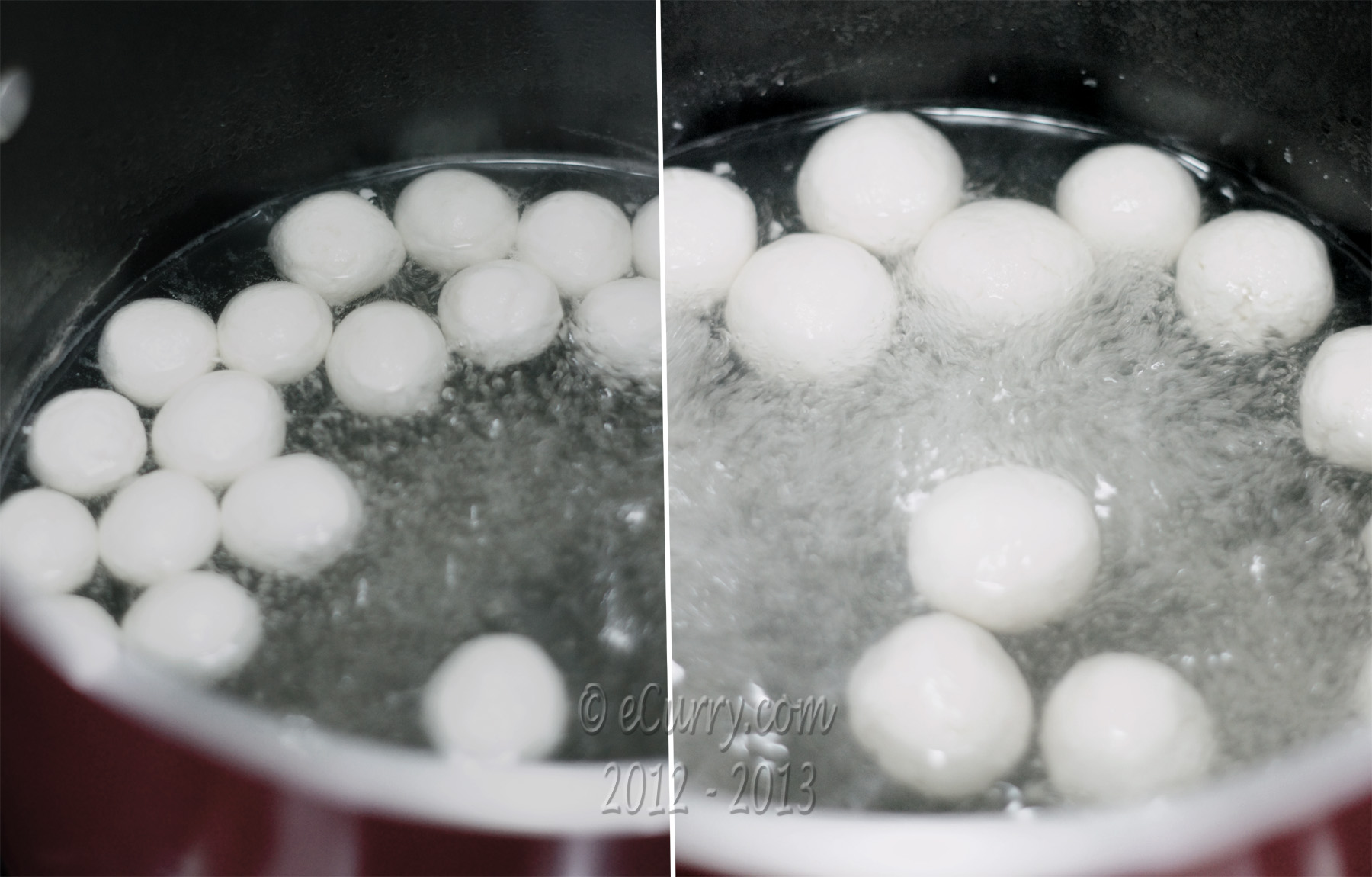
Remove the balls and place them in sugar syrup and add any flavors you want.
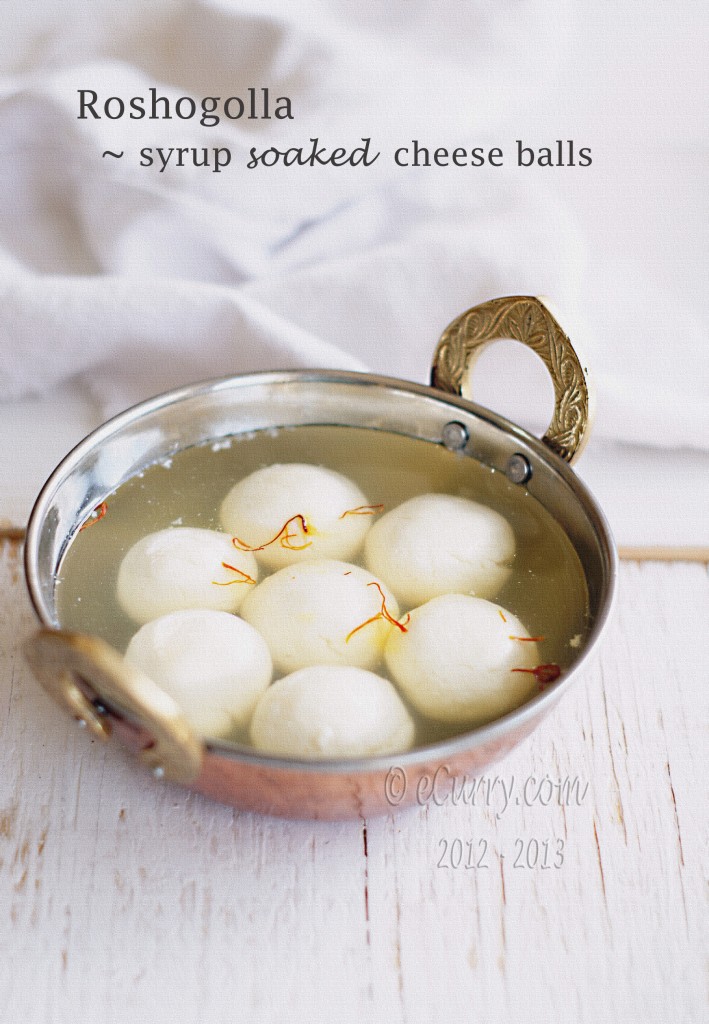
(The recipe is long. I have detailed every step and have included the details the process of cheese making from milk. )
Roshogolla/Rasgulla
Ingredients: (makes 40 small Rasgulla)
- 1 gallon milk
- 1/2 – 3/4 cup lemon juice/or white vinegar, approximately – (more or less – to be adjusted as per need – keep adding the juice in little amounts until the milk solid starts to separate)
- 10 cups water + more if needed
- 3.5 – 4 cups sugar + 1/4 cup extra large grain sugar
- orange extract/or saffron/or orange zest/ or cardamom or whatever flavor you want (Optional – the traditional Rasgullas have no flavors added )
- 1-2 tablespoon all purpose flour or fine semolina (optional) – to be used on the work surface*
*Note:
A lot of recipes use maida (all purpose flour) or fine semolina to make Rasgulla. I have used none. I never did. However, you may dust the work surface with some all purpose flour to make kneading and rolling easier on you.
If you need extra water or sugar, use it. The amounts are approximate here and might differ a bit in the process of making them.
Method:
If your Rasgullas get stiff and not spongy, here are a few reasons that could have caused it:
The chenna was not rightly done. If during the process of coagulating that milk, the milk solids harden (too much acid, too long in the whey after it split or cooked too long… could be all or any of these) the Rasgullas will not form right and hence will not puff and swell and get spongy.
The syrup got too thick. The syrup should be thin and light. As soon as you see the sugar has dissolved and water has come to a roaring boil, add your first set of the Rasgullas to cook. When the first set is done and you see that the syrup has thickened or reduced in volume, add more water and a little bit of sugar and allow it to come to a roaring boil again before you add another batch of the Rasgullas.
The Rasgullas cooked for too long: If you are using a pressure cooker with a whistle, it will take only one whistle for the Rasgullas to be done.(the time includes the cooker heating up and getting ready for the steam). If you are using a pot with a lid, it will take anywhere from 12 – 16 minutes, with opening a lid and releasing the steam once during the process. Remove the batch of Rasgullas with some syrup – enough for the cooked Rasgullas to be immersed completely and let them soak in this after they have been cooked.
If you cook them for too long they will start to lose the pure white color, and the smoothness of the texture. (They will finally turn this way but not during the cooking process but when they stay immersed in the syrup for a while). If they start looking this way while cooking, they will turn even more stiff after they are done.
The outside of the uncooked Rasgullas hardened/crusted. Cook the Rasgullas in batches. If they are overcrowded they will knock against each other and the chances are they might dissolve. They are very delicate and soft during the first few minutes. Besides, if you roll a lot the Rasgullas and leave them in open air, the outside of the Rasgullas will form a thin crusty layer and when you cook them, it will prevent the syrup to go in. So roll a few and cook them. While they are cooking, get the other batch ready.
Now let us start making them:
Making the Cheese/Chenna:
Pour the milk into a deep heavy bottomed pot. Bring the milk to a boil. When the milk comes to a roaring boil, addd the lemon juice (or vinegar) a little at a time (about a tablespoon), and lower the heat. Keep stirring the milk as you add the lemon juice.
After a few tablespoons (this amount might differ and if the milk has already started splitting you do not have to use up the entire amount mentioned above. On the other hand, if you need mre, use more), the milk will start separating and you will a greenish but clear (not milky looking) whey along with the curdled milk. Now immediately stop adding the lemon juice/or vinegar and stop stirring. If too much of the curdling agent, the chenna/ cheese will be tough and also sour.
Turn off the heat, remove the pot from the stove and allow the curdled milk to sit for about 8-12 minutes. Do not stir.
Collecting and Draining the Cheese/Chenna:
Place a cheese cloth or a very fine cotton cloth (make sure it is big enough as the cheese needs to be wrapped up and tied and hung) over a colander or strainer. You can place the colander/strainer over a large pot to collect the whey (the whey is healthy and can be actually be used to split the milk again for rasgulla!! or it is a good idea to make a bread dough with the whey in place of water).
Carefully pour/or remove with a ladle, the curdled milk into the lined colander. Give the chenna/cheese a quick wash with a spray of cold water. This removes the smell of the curdling agent and also prevents the cheese from getting stiff. Allow the whey to drain completely, about 15 – 30 minutes. You can loosely cover the cheese with one end of the cloth so the surface does not dry out and form a layer of crust.
Gather the end of the cheese cloth and wring out any extra moisture; hang it and allow any left over whey to drip out. (I will usually hang it to a cabinet knob or the tap of the kitchen sink.). Leave it this way for about an hour to 2 hours. When you squeeze there should be no more moisture dripping out and yet the cheese/chenna should not be completely dried out. It should be really soft and moist.
Kneading the Cheese/Chenna:
After hanging and draining, remove the cheese and soak it up in a layer of paper towels removing as much moisture. If you feel that it still feels too wet and not so well drained, spread it out in a plate and lightly cover with a wet cheese cloth/paper towel (so the top layer does not crust- yet allowing it to dry). Leave it this way for about half an hour. If the cheese if too wet, you will not be able to roll and the Rasgullas might break while cooking.
The kneading of the cheese is very important. You can either use a food processor, or knead with hand. After kneading it should be smooth and creamy like mascarpone cheese but when gathered into a ball, it should do so easily without leaving trails and smears on the board or the counter top. The kneading should be perfect and long enough so as the fat in the cheese comes out and prevents it from sticking. The consistency should be almost like a dough (but not stretchy like flour).
The kneading needs to be done well and for long enough to achieve the above mentioned texture – about 30 minutes if done by hand.
You may knead it over a board/stone/counter top or in a large tray. Sprinkle some all purpose flour on the surface if you need to. We usually knead it with the heel of the palm, and the palm. The way it is done is kneading parts of it away from you towards the outer edge and bringing it back to you and repeating the back and forth motion. It is a different kind of kneading than that of a bread. A food processor may be used too. The machine saves time and energy and works just well.
Rolling and Cooking the Cheese/Chenna to make Rasgullas:
Divide the dough into 40 rough portions (or less if you want Rasgullas of bigger size). Roll about 10 of them in your palms. Make a dent with your finger and insert a large grains sugar inside. (what this does while it cooks is creates a hollow, as the sugar melts and makes the rasgullas light and airy). Roll it back again until it has a really smooth surface with no cracks. They should be smooth without holes or lines going across them. So roll them well.
Make these in batches as you cook; if too many are rolled and left in the open, the surface dries up and forms a crust and when cooked they will be tough as the crust prevents the syrup from going in.
The sugar is added to the syrup in two steps. Only a little sugar is added the first time as less amount of sugar in the syrup allows the cheese balls to absorb the syrup better.
Add half the sugar to the water and bring the sugar and water to a boil until the sugar has completely dissolved and the solution is in roaring boil. Just before you add the chenna balls, reduce the heat to medium-high. If there are too many you might have to cook them in batches. After a couple of sets, the sugar syrup will thicken; add some hot water and some sugar to replenish and bring it back to the original consistency. The level of the liquid should be just high enough that the balls completely submerge.
Put a few balls in boiling syrup. Cover and cook. The balls will puff up in about 10 – 15 minutes. You may uncover and release the steam only once during the cooking process. Do not move around the balls as they are cooking. The cooking time will depend on the size of the ball. Remove the balls as soon as they puff up. An easy test to see if they are done is to remove one and drop it in a cup of cold water. If it floats, it needs to be further cooked. When they are done the texture should be spongy and should bounce back when held down with the back of a spoon or a finger.
Once each batch is cooked, remove them from the pot and place them in some sugar syrup which you can remove from the pot.
Once they are all cooked, add the rest of the sugar to the remaining syrup. (if you think there is too less syrup, add more water). Simmer until all sugar is absorbed. Remove pot from heat and add a cup of cold water. Now add the flavoring if you are using any ( I used saffron this time). Put the cooked Roshogollas back in this syrup and put in the refrigerate. Garnish with nuts if you wish too.
Serve cold or warm. I like it cold, except when they are just cooked. Then they are bliss to have them warm when just made.
Preparation Time: 1-3 hours
Cooking Time: 30 minutes
Difficulty Level: Intermediate – Difficult
Serves.Makes: 40 Rasgullas
Related Posts:
Kesar Pista Kulfi with Falooda (Saffron, Pistachio Ice Cream Served with Rose Infused Vermicilli)
Kheer – Indian Rice Pudding with Nuts and Saffron
Patishapta – Crêpes with Sweet Coconut Cardamom Filling
Quinoa Pudding with Rose and Pomegranate
Sabudana Kheer: Tapioca Pudding with Saffron and Nuts
Saffron Yogurt Mousse with Rose Petal Honey
Yogurt with Rose and Pomegranate

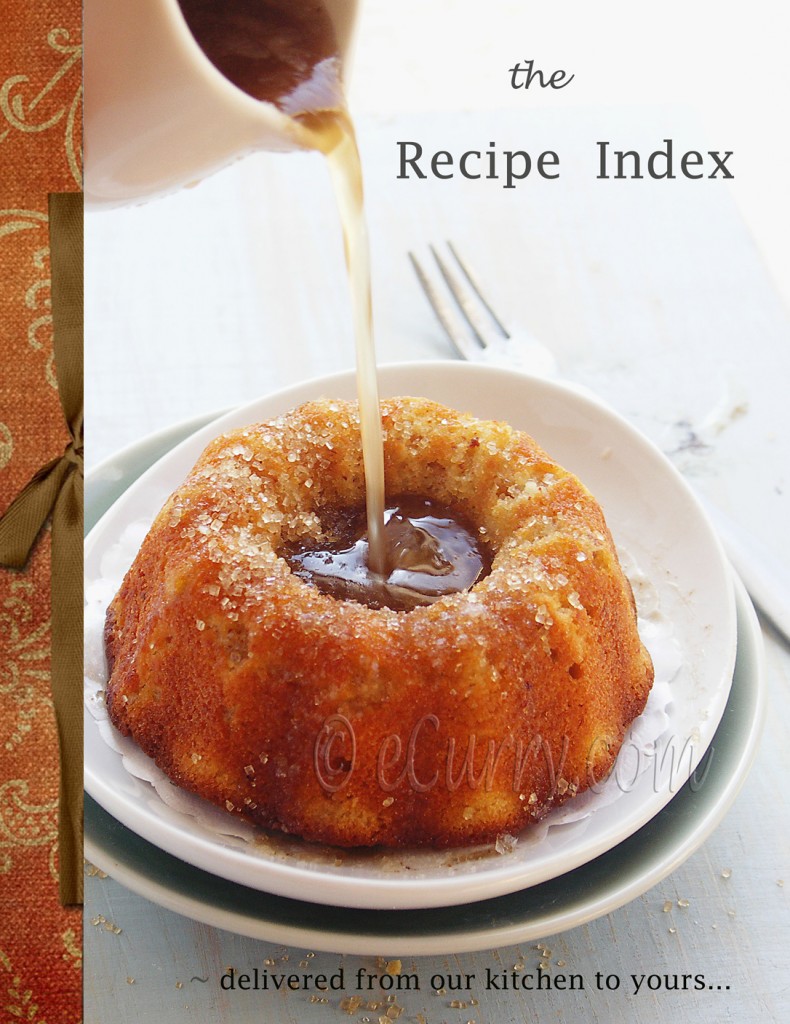
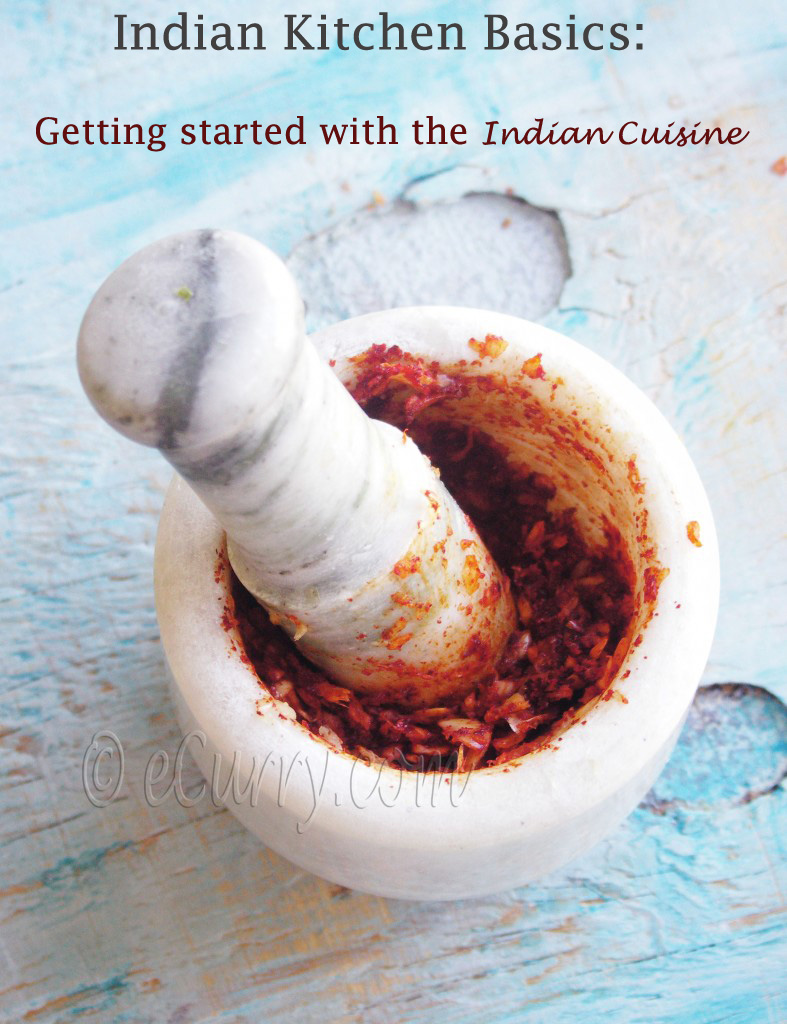
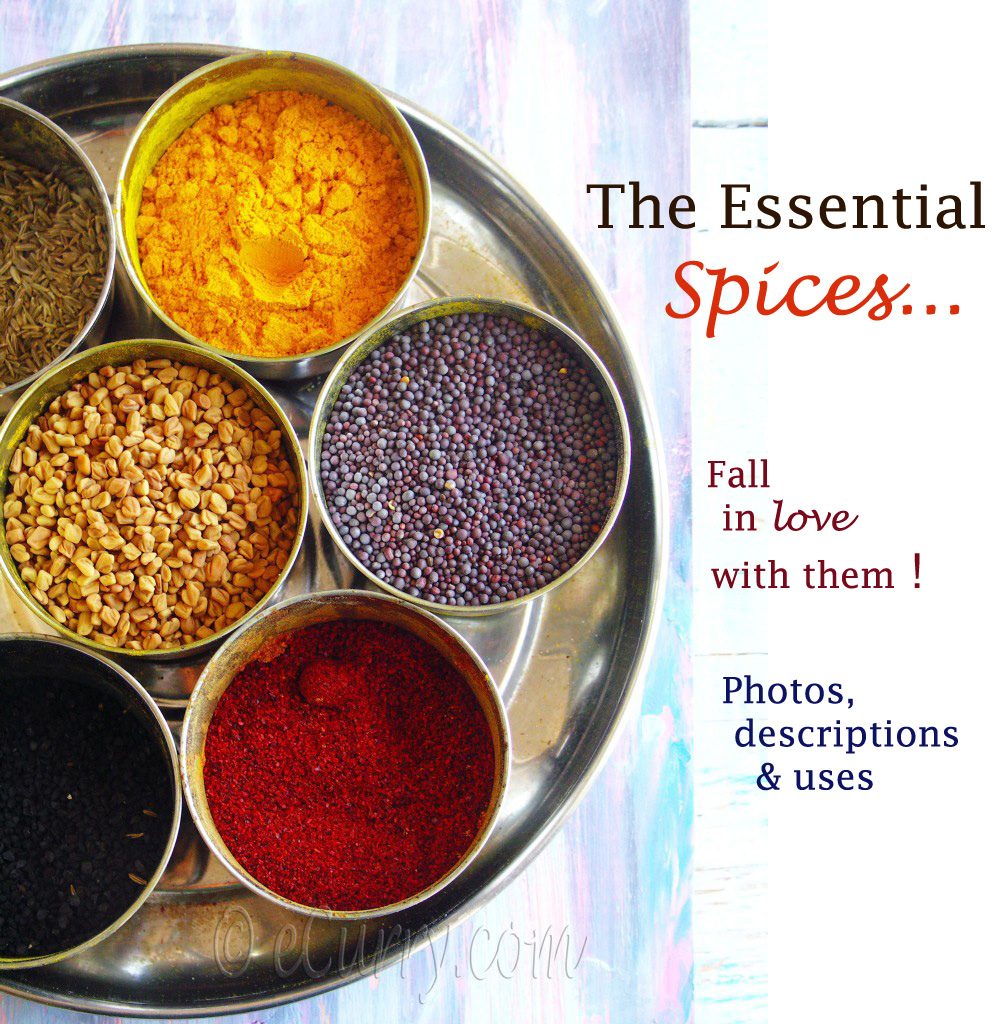








Hey wish you and your family the same for the festive season, your post is wow with detailed info & every step nicely shown..lovely “Ro-sho-gol-la” I must say 🙂
Thank you Soma for sharing with the beautiful clicks. I will make them very soon.
Ami aaj mishti doi banalum 🙂 Jodi photo bhalo uuthe tobe blog korbo bhabchi and then will link your post. Misti doi and roshogolla .. with these two, bengali cuisine is incomplete! Subho Durga Pujo. 🙂
A delightful speciality and wonderful recipe!
Cheers,
Rosa
Oh Soma, what a wonderful timing! I have planned to make paneer tomorrow and now looks like I will be trying my hands on to this recipe for the very first time. To be honest I was pretty scared to try out rashogolla recipe but now I have urs!! Wish me a luck.
Soma, ami rosogolla bananor jogot e notun. My first two batches were experimental and I’ve learnt from my mistakes…mistake being…follow the recipe to the ‘t’. Now that i am tamed, the rosogollas turn out all right.
I do prefer the ‘bhari’ ones which has a bit of ‘sooji’. What doesn’t work out becomes rasamalai. 😀
Amar Baba makes a good batch of gurer sandesh, which I can’t wait to eat in December!
Love to read your posts.
Shubho Durga Uthsav. Bhalo theko.
Lovely…The pictures look so inviting and make me wanna make these now.. 🙂
Shubho Saptami! If your post didn’t come today what would I have done? As it is there’s not much of Pujo happening here:( This is anyway my favourite topic – having written many posts perhaps. and intending to write many more. A beautifully, detailed and an elaborate post… and love the name ‘Gogosaaaas’!
May your entire family be blessed this Pujo. And yes, I’ve made Rasgullas at home – they have never been so perfect. And lastly, only you can make a steel bowl look drool worthy and desirable! Love:)
BTW, didn’t I chase you for Paneer making picture for my Pinboard? Pinning!
Dear Soma,
haven’t been here in a long time. What a lovely post! Thank you so much for these step by step instructions and photographs, it really will be of help when I make them. If you remember, I love bengali mithai- having lived my childhood years in Kolkatta and I know they are best eaten freshly made.
I know what you mean about ‘modernisation’ I have had this experience too.
Wishing you a joyous festive season too!
wow…these look super delicious..will definitely try these out asap 🙂 i really like rasgulla….drooling here 🙂
Rasgolla looks delicious and good to see the bonding of your kids with their grandfather..Durga Pujar Onek shubecha..hugs
This details will help me when I will make them. I like the way you have canned one. That comes handy when in hurry.
We have something very similar to Rasgulla in Lithuania. Just we don’t soak them in syrup, simply boil them and then eat with sour cream sauce 🙂 I love them! And it’s so easy to make then, cause we can find this kind of cheese in every store or supermarket 🙂
I love your pictures and the story behind!! 🙂
Wow!! amazing pictures… loved them! Wonderful post. My first time here, and I am just floored by your pictures! 🙂
Soma, shubho saptami! I lived in Dhaka so know a little but sbout Bengali traditions 🙂 Your photos are so, so besutiful, Soma. Sending love your way x
*beautiful
Bright pics. Love those sweet li’l hands helping Mommy out in the kitchen.
Wish you a happy Durga Pooja. I love roshogolla and tasted the authentic ones for the first time in shops near Kalighat. That was during my summer trip to Kolkotta. Pretty bright pictures and I can see the girls picking up the cooking skills from mom.
Beautiful post and pictures! I would love to try those cheese balls!
[…] sweet made with curdle milk and sugar syrup. If you wish to make Rasgulla at home, here is the recipe from Soma’s blog. The season of chilled yogurt is almost over, yet I would suggest you to […]
[…] during Durga Puja Mishti Doi/Sweetened YoghurtMitha Chawal/Sweet Rice Mutton without Onion Garlic Rasgulla/Roshogolla Durga Pujo Card collaborately made by the […]
Such a lovely detailed post. You really want us to get those rosagullas right, don’t you 🙂 Thanks.. And a Happy Pujo to you!
I never heard about them before.. they look really really good! And I would really liek to try… I have made cheese before.
Ciao.
happy durga pooja to you & family 🙂 i think you can easily compose a poem on roshogollas 😉 it’s such a joyous name for a sweet
Lovely post Soma. After reading this post i will surely try out these.
-Suparna
Yum! They look perfect and inviting.
Very well explained. nice clicks 🙂
That is a delicious….. Its my favorite dessert… mouthwatering.
Hey Soma,
We just made rasgullas, following your recipe to the tee. They have come out really well. Thank you for presenting the recipe in such detail.
Regards
Gomathi and Aparna
Thank you!
Apologies if I missed this — is there a best way to store the uneaten ones for the next day?
They will stay for upto a week or a bit more if stored in the syrup and refrigerated.
[…] 1 , Recipe: 2 , Recipe 3 , Recipe 4 , Recipe 5 , Recipe […]
hi , my rasgulla becomes flat after cooking and becomes very soft and sponge. but making round balls and boiling them still makes them flat , what is the reason?
[…] perfect Rasgulla but if you want to know more detailed version of the recipe then Soma’s eCurry is the page for you, where she has covered minutest detailed information required for making […]
hi, i made rasgullas but as soon as I dropped them in boiling water-sugar syrup, they got dissolved!! What could be the reason?
Can i do something with this syrup now?
I am sorry! I think the chana would still have had water in it. That is the most possible reason why it happens. Nut sure what you could do with the syrup now. All I can think of is straining it but I doubt you can strain out the paneer from the water.
Hi,
I am getting good spongy rasgullas out of this method – but the rasgullas are not round – they are becoming flat like batasha after soaking in sugar syrup 🙁
Any suggestions to make these little white wonders hold their shape?
All rasgullas do ten to flatten a bit once it is removed from the boiling syrup and it cools. I am sorry I really do not know how to fix that. I know some mix flour or sooji/semolina, but I like to do without. Not sure if that would help. Try making smaller balls and see what happens.
THE BEST and MOST comprehensive roshogolla recipe I have come across so far. For many years I tried so many recipes but they never worked completely. Something was always amiss and the roshogollas will turn out not as spongy as I would like. But not this time, this time they were perfect all thanks to you. Really really appreciate the time you spent in covering every small detail about making these and the lovely personal history behind, was also very nostalgic. Took many of us back in memory lane I am sure. Thank you very very much again. Love!
Really really appreciate you writing back and the sweet words.Every reader’s success story makes me happy, very happy. Makes what I do worthwhile 🙂 Thank you so much!
[…] perfect Rasgulla but if you want to know more detailed version of the recipe then Soma’s eCurry is the page for you, where she has covered minutest detailed information required for making […]
Very nice and delicious rasgulla, you nailed everything in rasgulla making.
wowow….am totally speechless !! dint actually know that rasgullas can be made so perfect at home !!
[…] as they improve in taste as they soak up the flavors from the syrup. Taken almost verbatim from Ecurry, the recipe details every little tip to get the Bengali rasgulla as close to the authentic as it […]